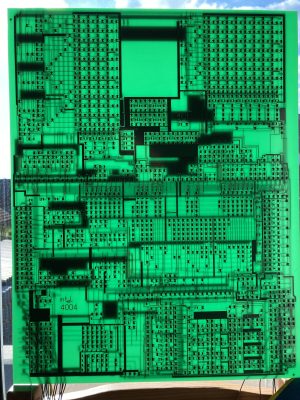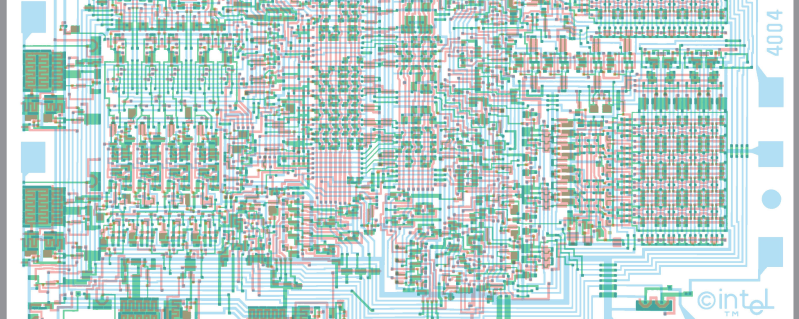
The Intel 4004 was among the first microprocessors and one of the first to use the MOS silicon-gate technology. In the decades long race to build bigger CPUs, it’s been mostly forgotten. Forgotten that is, until [Klaus Scheffler] supersized it over ten-fold!
The project took about 2 years to complete and re-creates it faithfully – all 2,300 transistors included – enough to run software written for the Intel 4004. But the idea for this project isn’t unique and dates all the way back to 2000, so what gives? Turning a bunch of masks for silicon fabrication into a schematic is actually harder than it seems! [Tim McNerney] originally came up with the idea to make a giant 4004 for its “35th anniversary”. [Tim] managed to convince Intel to give him schematics and other drawings and would in return make an exhibit for Intel’s museum. With the schematic straight from [Federico Faggin], software analysis tools from [Lajos Kintli] and [Klaus Scheffler] to actually build the thing, they did what [Federico] did in one year without CAD, but in two with modern tools.
The full story by [Tim] is a lot longer and it’s definitely worth a read.
















Awwww! Gee whiz!
I was hoping he was going to give it 10 times the data and address lines!
Shucks!
“The project took about 2 years to complete and re-creates it faithfully – all 2,300 transistors included – enough to run software written for the Intel 4004. ”
I do admire the efforts a lot, but what kind of software was there, actually?
Can an 4004 handle, ASCII, even? It’s 7-Bit, at least.
Baudot is 5-Bit, not counting start/stop bits.
I don’t know about the 4004, but the 8048 was a 4-bit CPU in that it had a 4-bit ALU, but it had 8-bit memory and handled ASCII quite well. It did mean that 8-bit math instructions were quite slow since they involved a lot of steps to shuffle the halves of the octet around.
The first firmware written for the 4004 was for a desktop printing calculator.
True, not great for ASCII, but digit-by-digit BCD arithmetic works fine in 4-bit “nibbles.”
The closest thing to a 4004 “killer app” was the world first electronic taxi meter…
…or maybe it was the countless traffic light controllers we hardly think about.
HP used “younger brother” 4040 to affordably automate electronic test equipment.
It was originally created to be the core of a chipset for electronic calculators. It greatly consolidated the components needed and paved the way for pocket calculators. That it could be used for more general computing was a bonus and used in embedded controller applications.
Numbers were stored in BCD (Binary Coded Decimal) so numbers 00-99 (Decimal) would consume two 4-bit words and 7-bit ASCII would take 3. It’s not so much whether it supports ASCII or not but more a matter of how efficient lly it would. It would make more sense then to use a reduced set that could be contained inside 100 values.
Great project!
This chip was at the start of a journey that has changed the world.
The name is “Federico Faggin” and not “Frederico Faggin”
Thanks, I corrected it.
The processor that got me into computing. A long rime ago I a galaxy far far away. A small project to control a piece of equipment in a factory. Assembler, 2k ofnUV EPPROM.
Wow, nice project. Congratulations!
Also on locating remaining stock of true planar NMOS transistors :). I wish more were available
Catalogic SST211 / SST213 / SST215 family “FAST DMOS FET Switches
N-Channel Enhancement-Mode”
How serendipitous! I was just looking for this build yesterday, thanks Julian!!!
Yeah! An article about the lowly 4004. Yes, a short lived 4 bit CPU. Superseded by the 8008.
Not nearly as much is written about the 8008, an 8-bit microprocessor originally designed for a video display terminal (text only CRT display + keyboard). Datapoint contracted both Intel and TI to build this architecture, but then abandoned the project. It’s worth noting that the 4004 was manufactured from 1971 until 1986. Meanwhile many, many more powerful microprocessors and true, one-chip microcontrollers were launched, like the 8051, still in use today, even though Intel got out of the microcontroller business years ago.
When I read the manual for 8052 I was hooked. Wire wrapped a board but no boot. Testing chops I my thumb squarely on a 2712. Thje ceramic chip was very hot and left a sizling image of window on my thumb. Ended up buying Raw boards from Basicon.
was this built from silicon wafers or discrete parts?
Lots and lots of discrete parts.
You probably can build a 4004 or 4040 on a pcb with modern 74f gates and it probably would rum faster than a 4004 or 4040 ic itself
Because the transistor switching and propagation delay is much shorter, so you could run faster than about 630 meters
It was my original plan to use TI Little Logic to build a big-enough-to-see 4004, but when I saw the schematics, it was all at the transistor level, and there was never any logic diagram according to Federico Faggin. All the 4004’s logic is level-sensitive, wereas the 74-series (mostly?) uses edge-triggered clocking.
I put forth this challenge: translate the 4004 schematics (available at https://4004.com) into a gate-level schematic that faithfully maintains all the internal timing of the original chip, verify it in simulation, and I will build your design out of “little” TI BGA packages. Yes, it will probably be faster than the original. Microprocessors were not mainstream in the early 1970s because TTL and ECL computers were still faster.
Reminds me of that 6502 made of discrete components.